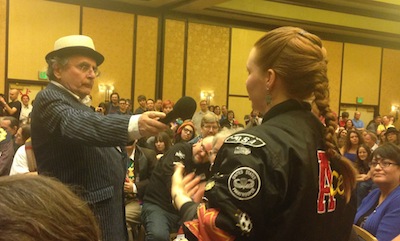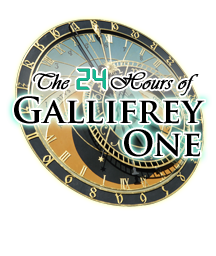My notes from Sylvester McCoy’s Q&A on Saturday are sparse to nonexistent, and the most notable feature therein is the sentence, “Nothing I write is going to get across the insanity that is this Q&A.”
After you’ve gone to enough conventions, you often find panels or Q&A sessions settling into a fairly predictable pattern, to the extent that you don’t really go into it expecting to be shocked. Oh, it’ll be enjoyable no matter what, if it’s work that you’re interested in, but usually, assuming a good moderator, you can be confident of considered questions, equally considered answers, and audience questions that range from predictable to predictably deranged.
What you don’t expect—unless you’ve been fortunate enough to see McCoy in action before, which I hadn’t—is for the star to immediately bound off the stage and into the audience, personally walking up to the people with their hands up to hand them the mic.

McCoy fielded an extraordinary range of questions in his allotted hour—lots of questions on The Hobbit (in which we learned that Peter Jackson owns one of McCoy’s Seventh Doctor costumes and very nearly showed up at a party wearing it—McCoy professed to be very concerned now for the well-being of his own street clothes) and also quite a few about his work on Big Finish’s audio range. Putative moderators Nicholas Briggs and Jason Haigh-Ellery were there to reel things in if they got too out of hand—and also to show off the trailer for “The Light at the End”, Big Finish’s special release for Doctor Who’s 50th anniversary release. But they were also available also to stand in for Prince William and Cate Blanchett in a re-enactment of McCoy’s meeting with the future king of England…in which McCoy, to his alarm, found himself swearing and talking about bird poo.
He popped the bubble wrap on the Zoe costume worn by one questioner, advised a pair of tween boys that despite his having done so, they should not hammer nails up their noses, and responded with hilarity and grace to a questioner who claimed to be telepathically transmitting a question from the lady sitting next to him. He didn’t hesistate to let a bit of an edge into his answers—lightning fast and always funny—if a question seemed silly or redundant, but whenever the questioner was a child, he always treated their questions with utter seriousness and sweetness.
The other sessions I attended today were rather more conventional by comparison—but credit must be given to the Gallifrey One organizers for having assembled a truly top-notch team of moderators and interviewers—Gary Russell, Charlie Ross, Richard Dinnick, and Scott Handcock, to name just a few. This is an arena where being an insider is a huge asset—they know what questions to ask and are skilled at keeping the discussion moving. Charlie Ross did a particularly impressive job juggling ten actors from across Doctor Who and The Sarah Jane Adventures: Frances Barber, Shaun Dingwall, Neve McIntosh, Anjli Mohindra, Finn Jones, Ian McNeice, Dan Starkey, Nina Toussaint-White, Paul Marc Davis, and Richard Hope. (If you can name who each of these people played on Who and/or SJA without looking it up, I will personally send you a prize.)
The acting panels and interviews do tend to be the most heavily attended—Freema Agyeman has been booked for two slots in the weekend, one on Saturday evening and one for Sunday morning, and attendees have been encouraged to do the civil thing and not show up for both. Interviewed by Gary Russell, she spoke at length about the transforming effect that Doctor Who has had on her career, and how she has had to learn to be a public figure. The full impact of what it meant, she said, struck her when the casting director told her about a daughter of a friend who decided she wanted to do a project about Martha Jones for Black History Month at school.
She also spoke frankly about some of the decisions made about Martha’s character—she did think that perhaps Martha did become “too forlorn” in her unrequited love for the Doctor, and was as surprised as anyone to discover that Martha and Mickey were married by the end of Tennant’s run. She is now working in America on The Carrie Diaries; asked what’s different about doing TV in the US versus the UK, she spoke about the wonders of on-set craft services, the slight embarrassment of having a stand-in to do the boring bits of setting the lights, and the chairs with the character names stitched on—“it’s things like that that make me pinch myself and go, ‘it’s Hollywood, baby!’”
I was a little surprised to see Philip Hinchcliffe’s session rather sparsely attended, since he oversaw one of the most popular (and by many fans’ standards, the best) eras in the show’s history. He recalled seeing the first episode when he was 18—a day he remembered more for having gotten his place at university than for this “load of rubbish” children’s show. Eleven years later, he took over Doctor Who from Barry Letts, where he worked out that all the children who wanted to watch the show were already watching, and he wanted to bring in more adult viewers. With that in mind, he and script editor Robert Holmes worked on tightening up the storytelling and making the show more compelling to watch.
Under his watch, the show visited Gallifrey for the first time—Hinchcliffe said that he’d originally envisioned the Time Lords as something more like the CIA or the Kremlin—“good guys on the outside but very dangerous”—rather than the stuffy, Oxford don-like figures who ended up in “The Deadly Assassin.” Leela was also introduced; according to Hinchcliffe, she was originally meant to be a kind of Eliza Doolittle figure, possibly even Victorian, who the Doctor could educate and culture. He also wanted to have an heroic girl character—one of his neighbors had an eight-year-old daughter who made him realize that girls were just as engaged with the show as boys. He didn’t realize how short and skimpy Leela’s final costume would end up being, and while “the dads loved it!” he noted that she was really meant more for the young girls in the audience, a point which the Gally audience cheered enthusiastically.
I recall suggesting a couple of years ago that Gallifrey One ought to do some kind of panel or session on the music of Doctor Who, and they did organize a panel—although it was more to do with the new series compositions and not the Radiophonic Workshop, which was what I’d had in mind. But this year they brought in Dick Mills, who worked as a sound engineer in the Radiophonic Workshop alongside Delia Derbyshire, and who helped her create the Doctor Who theme. The Workshop, he said wryly, “started out producing sounds nobody liked for plays no one could understand.” He went to work there after leaving a job at an insurance company and doing a stint in the Royal Air Force; an ad for a technical assistant led him to the Maida Vale studios that were filled with redundant equipment borrowed from other sources, including an oscillator that they nicknamed “the wobbulator” that had originally been used to test sound equipment.
In his presentation, he showed off photographs of the studio and samples of their work—effects from Quatermass and the Pit, The Goon Show, and of course, the Doctor Who theme, the TARDIS landing sound, and the Dalek voices. For the Who theme, he and Derbyshire created tracks: the bass track (“dong-de-dong, dong-de-dong”), the “ooooh-eeee” track, which was made on the wobbulator, and the “whooshy bits,” which were white noise. At one point they discovered there was a bum note somewhere in the mix, so he and Derbyshire unrolled the tapes down the very long corridor at Maida Vale until they found a spot where a bit of splicing tape was sticking out.
The TARDIS landing sound was adapted by Brian Hodgson from the sound made by running his mother’s house key down the strings of an old piano. For the Dalek voices, they used a ring modulator circuit with two inputs—one for the actor’s voice, and one for an oscillator, which allowed the voices to be recorded live. A simple solution, but as Mills pointed out, because of the pace of work, one always had to improvise and make use of what happened to be lying around. The methodology didn’t really change with the advent of computers and sequencers, but it did make things easier.
Mills has since received an honorary doctorate from Bradford University in the UK after doing a similar presentation on radiophonics and music synthesis—his son, he said, attended the same university and worked very hard on his mathematics degree, and then “dear old dad swans up there for an hour and a half and gets a floppy hat and a ball gown.”
Next: An assortment of panels, the fun of live director commentary, and a wrap-up.
Karin Kross lives and writes in Austin, TX. She can be found elsewhere on Tumblr and Twitter.










